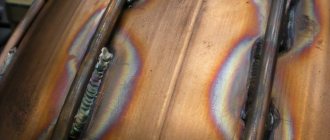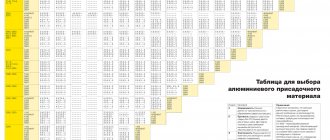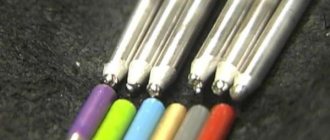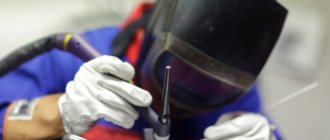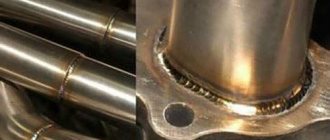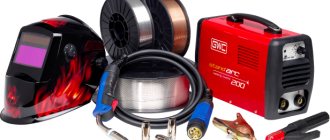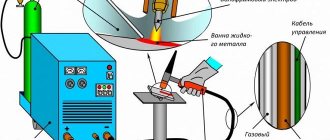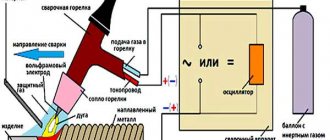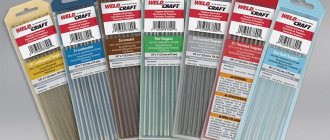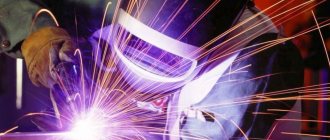05.21.2019 Author: VT-METALL
Issues discussed in the material:
- What you need to know about welding titanium with argon
- How to properly prepare for the titanium argon welding process
- How to weld titanium with argon
- What defects can appear during welding of titanium with argon and how to eliminate them
Among other metals, titanium stands out for its low weight and ability to resist corrosion. For this reason, it is actively used in the production of complex components for the needs of aviation, shipbuilding, and mechanical engineering. In this article we will talk about this type of processing, such as titanium argon welding.
Technology and features of titanium argon welding
Welding titanium is challenging because it requires very high temperatures to melt it. However, when heated strongly, this metal becomes chemically very reactive to the gases contained in the air.
Not everyone knows, but titanium, being one of the strongest metals on our planet, is quite often found in nature - even more often than, for example, zinc or copper. This dull gray metal melts at 1700 °C. From a technical point of view, its main value, as we have already said, is its high resistance to rust, as well as relatively low heat during welding.
The melting point of titanium alloys depends on the grade and ranges from 1470 – 1825 °C. Compared to other types of metals, they are lightweight (due to low density) with high strength, which is why they are used as a material for bicycle frames and racing car parts. But you need to understand that the specific properties of alloys turn their welding into a complex process.
VT-metall offers services:
It should be noted that the metal can be in one of the stable phases; they are denoted by the Latin letters α and β:
- The α phase is a state at ambient temperature, while the metal has a fine-grained structure and is completely inert to the cooling rate.
- Phase β is reached at temperatures above 880 0C: the grain becomes larger, and sensitivity to cooling (process speed) occurs.
These phases are stabilized with the help of additives and alloying elements: O, N, Al (for α) or V, Cr, Mn (for β). For this reason, all titanium alloys are usually divided into groups according to the type of additives used:
- VT1 – VT5.1 These are the so-called α-alloys. They are distinguished by their ductility and weld well, but their strength is not increased by heat treatment.
- VT 15 – 22. β-alloys that weld less well, often with the appearance of cold cracks. The quality of the connection of segments is negatively affected by the fact that during welding the grains of the structure increase in size. However, heat treatment can partially increase the strength of the alloy.
- VT4 – 8, OT4. Group α + β. The properties of such intermediate alloys depend on the type and proportion of additives used.
It is worth dwelling in more detail on the properties of titanium, which make welding work difficult:
- density 4.51 g/cm³;
- strength 267 – 337 MPa;
- melting point 1668 0C;
- low thermal conductivity;
- possibility of spontaneous combustion when heated to 400 °C and in contact with oxygen;
- oxidation with carbon dioxide;
- formation of hard but brittle nitride compounds when heated to 600 °C and direct contact with nitrogen;
- ability to absorb hydrogen when reaching 250 °C;
- grain increase at 880 °C and above.
An increase in temperature to 400 – 500 °C or more is critical for titanium. Strong heating entails a sharp increase in chemical activity, due to which the metal reacts with atmospheric air. All this negatively affects the strength of the weld; hydrides, nitrides, carbides, etc. are formed. Failure to comply with GOST may result in the seam not being able to withstand even a light blow.
Argon welding carried out according to all the rules ensures a weld strength of 0.6 - 0.8 of the metal itself.
For welds, GOST R ISO 5817-2009 applies; it fixes the quality of welding of the following metals: steel, titanium, nickel, their alloys, and the maximum permissible levels of product defects.
Pure titanium is little used in production due to insufficient strength. Therefore, if we are talking, for example, about welding titanium with argon, we mean some kind of alloy, in other words, titanium and an alloying element.
Alloys
Titanium-based compounds melt at a temperature of 1468-1830°C . The elements are characterized by increased corrosion and heat resistance. Alloys are easily hardened with the introduction of additives that reduce ductility - vanadium, chromium, manganese.
When heated to 400°C, the metal actively reacts with nitrogen and oxygen in the air. When heated to 800°C, the granularity and porosity of the metal increases. Therefore, welding of titanium parts should be carried out without exposure to oxidizing gases.
How to properly prepare parts for welding titanium with argon
Welding titanium with argon is carried out with complete isolation of the welded surfaces from the atmosphere, therefore automatic or semi-automatic technology is most often used.
Of course, manual welding of this metal is possible, but it uses a special torch with a ceramic nozzle: through it, an inert gas, argon, is supplied under pressure, which displaces the air.
The diagram shows devices for protecting the seam with gas and supplying it in an increased volume.
Before welding titanium with argon, edges and additives are prepared, so we also provide a table for preparing edges.
It is necessary to clean metal surfaces with a steel brush, sandpaper, and degrease.
One of the most common solvents for degreasing metal surfaces is acetone, but it has a strong odor and is quite toxic. This is evidenced by the fact that acetone belongs to hazard class 4. When inhaled for short periods of time, its moderate and high concentrations cause irritation of the eyes, respiratory tract, increased heart rate, headaches, nausea, vomiting, and even clinical coma is possible.
We recommend articles on metalworking
- Steel grades: classification and interpretation
- Aluminum grades and areas of their application
- Defects in metal products: causes and search methods
Therefore, it is worth choosing safer but more effective compositions for cleaning metal surfaces. One option is denatured alcohol, which is applied to the metal with a lint-free cloth. This is alcohol with additives that make it impossible to consume. On the one hand, they have a terrible taste, and on the other, they cause vomiting and can even cause blindness.
Before joining, titanium parts are etched with a mixture of hydrochloric acid, water and sodium fluoride in the following proportion: 350 ml HCl, 650 ml distilled water, 50 g sodium fluoride. Etching takes about 10 minutes at 60 – 65 °C.
Another method that allows you to remove the oxide film is a mixture of 2 - 4% hydrofluoric acid and 30 - 40% nitric acid. Etching lasts 30 seconds and the temperature does not exceed 60 °C.
After this, the metal is thoroughly polished using sandpaper up to No. 12, wire brushes, and a scraper. It is important to make sure that the edges of the parts are smooth and free of burrs and cracks. The filler wire for welding titanium with argon is also cleaned in the same way. Next, it's time to move on to welding.
Work in an argon protective gas environment is carried out using filler materials. The latter are divided into groups according to composition (palladium, vanadium, aluminum) and the proportion of oxygen contained in them. The table contains the characteristics of additives made of titanium and its alloy:
It is very important that the rods and wires when welding titanium do not come out from under the gas protection, since the additives become contaminated in the air.
Argon-arc technology requires the use of direct current of direct polarity and tungsten electrodes. Sometimes you have to use special devices into which inert gas enters, displacing the air.
It is possible to weld titanium with argon using copper and steel pads. They have holes for gas supply.
To connect pipes, special aprons with different curves are used, whose characteristics are determined by the diameter of the pipe.
Semi-automatic or automatic technologies are carried out in a special capsule filled with argon or helium. When it comes to pipes, they are not placed in a protective environment, but are sealed and filled with argon.
Another important requirement for such work is the presence of gloves on your hands, because even clean hands leave sweat marks on the edges. The latter negatively affect the quality of the weld.
Preparatory work
To make the seam strong, it is necessary to carry out preparatory work:
- Most metal products made of titanium are coated with a protective film of the oxide-nitrate type. The film appears naturally during the heat treatment of metals. Before welding, it is necessary to get rid of this film, since it will reduce the quality. To do this, it is necessary to etch the metal in a mixture based on sodium fluoride (1 part), water (13 parts) and hydrochloric acid (7 parts). Etching time is no more than 10 minutes, temperature is about 50-60 degrees.
- Also, before welding, it is necessary to clean the edge of the metal object where the weld will lie. It is recommended to use high-hardness metal brushes for cleaning. In addition to the edge, it is also recommended to clean the area located within a radius of 1.5-3 centimeters from the joint. After cleaning, you must not forget to degrease the metal (using alcohol or any other reagent).
- Before work, it is also recommended to select a rod that will act as the basis for the weld. The chemical composition of the rod is of paramount importance. The welded rod and the parts to be welded must have approximately the same composition in order for the weld to be strong. The more different the composition is, the higher the chance of cracks and defects appearing.
Methods for welding titanium with argon
Titanium welding is carried out using both the “cold” method and the flux-arc method or using plasma-arc welding. However, the most widely used method is welding titanium with argon, that is, by melting in an isolated argon environment, the so-called TIG welding.
To connect large cross-section parts, the method of electroslag welding with argon is used.
The type of alloy plays an important role. So, let us remind you that titanium grades VT1-VT5 are excellent for welding, although they cannot be hardened. Alloys VT15 - VT22 weld much worse, forming a coarse-grained, relatively weak weld, but hardening can increase its strength. Other types of titanium alloys are considered intermediate.
Today the following types of resistance welding with argon are used:
- butt;
- point;
- roller;
- condenser butt (for pipes).
When working with flux, oxygen-free flux AN-11 or AN-T2 is used.
Manual welding of alloys with titanium argon is carried out with direct current of direct polarity in the range of 90 - 200 A. Note that this indicator depends on the thickness of the parts being joined, the caliber of the electrode and the diameter of the filler wire.
Watch the color of the resulting seam. If you have a bright silver seam in front of you, everything is fine. Whereas a yellowish or blue tint indicates that the supply of shielding gas was stopped early. The worst option is gray, dark blue or whitish joints, since they need to be completely removed and the joints thoroughly cleaned for rejoining. For cleaning, use a stainless steel metal brush.
Electroslag
For titanium alloys with high tin or aluminum content, electroslag welding technology can be very often used. This technology is quite complex, and to master it it is recommended to obtain appropriate education. Main features of electroslag technology:
- For large parts with large cross-sections, it is recommended to use fluxes in argon. This will ensure high quality protection of parts.
- When welding small parts, fluxes do not need to be used. Optimal technical operating parameters: current - 1700 amperes, voltage - 15 volts, argon flow - about 7 liters per minute.
- For extruded profiles, it is better not to use electroslag welding. The strength in this case will be quite low compared to alternative technologies.
Nuances of manual welding of titanium in argon
It is possible to achieve a strong weld when welding titanium with argon by ensuring the cleanliness of the surface of the parts and the additive. Another prerequisite is the correct setting of the welding machine. If the argon welding technique is not followed, welding defects always appear at the weld site. Before starting work, purge and clean the burner and protective nozzle. Do not forget about the backing pads for the back of the seam - with their help you can check the presence of air in the system.
Welding is carried out without preheating. The exception is situations when humidity or condensation on titanium is possible - then heating to 70 °C is required.
With TIG technology, high-frequency arc ignition is recommended. When you work with an additive, the arc length is equal to 1 - 1.5 times the electrode cross-section. If argon welding is performed without an additive, this parameter corresponds to the diameter of the tungsten electrode. Remember that tungsten particles remain in the scratches that form on the metal when touching the tungsten electrodes. When all work is completed, the arc should fade out gradually; to do this, gradually reduce the current. Protection of the weld and heat-affected zone is also ensured after the arc is turned off, when the temperature drops to 427 °C.
When connecting thin-walled parts with argon, the gap between the edges should be 0.5 - 1.5 mm. In this case, you can avoid forming edges and dispense with filler wire. By the way, the latter must match the composition of the main metal being welded.
Welding titanium with argon involves the following modes: if a tungsten electrode with a diameter of 1.5 - 2 mm and a filler wire with a diameter of 2 mm are used, and the thickness of the workpieces being welded is 2 mm, a current of 90 - 100 amperes must be maintained. Increasing the thickness of the metal to 4 mm allows it to be welded with a current of 120 - 140 amperes. And the most important thing to remember: to work with titanium and its alloys, alternating current of constant polarity is used.
There are also a number of other essential conditions for high-quality welding of titanium with argon:
- For manual technology, a short arc is used, vibrations of the electrode and additives are not allowed. The welder moves along the seam.
- Welding is carried out at an angle forward, that is, the electrode should be directed in the direction opposite to the direction of movement.
- The angle between the additive and the electrode is 90°.
- The additive is fed into the weld pool continuously.
- After the arc is extinguished, the shielding gas continues to flow, providing cooling below 400 0C, on average this takes a minute.
Further cooling of the metal is a guarantee of a high-quality weld. You can tell by the color. Normally, the seam is light, straw, yellow. But grey, bluish or black indicate oxidation, which has a bad effect on quality.
The technology of semi-automatic or automatic argon welding is the same as manual welding. The only nuance that should not be forgotten is the holes in the burner nozzle. In accordance with GOST, their diameter is 12 - 15 mm. It is recommended to light and extinguish the burner on special linings and slats.
Welding process
Conditions
- The electrode is tungsten.
- The current is constant, of straight polarity.
- Wire feed is continuous.
Manual welding of titanium is possible if it is possible to organize local protection of the working area. Let us remember that metal oxidizes quite quickly. Protection from this on the front side is provided by a gas jet (argon + helium). What about the back? The most common option is pads made of copper or steel, which are pressed tightly to the junction of the welded edges. But this is applicable if simple configuration parts are processed.
Samples that are complex in this regard, when the seam changes direction quite often, are welded in special chambers, in semi- or fully automatic mode. In such a closed volume, the gas environment can be controlled and maintained at the required level. The working chambers are first evacuated and then filled with argon. The master welds in a special suit.
Before starting the operation, the quality of edge cleaning is checked. It is enough to pass a white napkin or cloth over the areas of the future working area to understand whether another, additional, “finishing” preparation of the metal is necessary.
How is automatic titanium welding performed?
A tungsten electrode is used for this. Moreover, the size of the welding torch holes should be in the range of 12 – 15 mm. It is also necessary to take into account that it is better to make a connection with a non-consumable electrode using direct current of straight polarity.
The high activity of titanium forces the burner to be lit and extinguished on special strips, outside the product. As with manual technology, gas is supplied for another 1 minute after extinguishing the arc, protecting the seam and transition zone from oxidation. The following are the modes for automatic welding of titanium with argon in shielding gases and submerged arc:
| Metal thickness, mm | Diameter of tungsten electrode, mm | Voltage, V | Current strength, A | Welding speed, m/h | Argon consumption, l/min | |
| In the burner | In the lining on the reverse side of the seam | |||||
| 0,8 | 1,0 – 1,5 | 8 – 10 | 45 – 55 | 18 – 25 | 6 – 8 | 3 – 4 |
| 1,0 | 1,5 | 10 – 12 | 50 – 60 | 18 – 22 | 6 – 8 | 3 – 4 |
| 1,2 | 1,5 | 10 – 12 | 55 – 65 | 18 – 22 | 6 – 8 | 3 – 4 |
| 1,5 | 1,5 | 11 – 13 | 70 – 90 | 18 – 22 | 9 | 3 – 4 |
| 1,8 | 1,5 | 11 – 13 | 80 – 100 | 18 – 22 | 9 | 3 – 4 |
| 2,0 | 1,5 – 2,0 | 11 – 13 | 110 – 130 | 18 – 22 | 9 | 3 – 4 |
| 2,5 | 2,0 – 2,5 | 11 – 13 | 150 – 180 | 20 – 22 | 9 – 12 | 3 – 4 |
| 3,0 | 2,5 – 3,0 | 12 – 13 | 200 – 220 | 20 – 22 | 9 – 12 | 3 – 4 |
Submerged arc operating modes:
| Metal thickness, mm | Connection type | Current strength, A | Operating voltage, V | Welding speed, m/h |
| 3 – 5 | Butt | 250 – 320 | 24 – 38 | 50 |
| 3 – 5 | Angular | 250 – 300 | 32 – 36 | 40 – 50 |
| 2 – 3 | overlap | 250 – 300 | 30 – 35 | 40 |
Possible defects when welding titanium with argon and ways to eliminate them
The only way to avoid defects when joining titanium elements with argon is to use a laser; in all other cases, errors are possible. GOST determines that defects appear due to non-compliance with technical conditions, violation of technology, as a result of which the design becomes unsuitable for use.
According to GOST, defects are divided into the following types:
- cracks;
- pores;
- solid formations;
- lack of fusion;
- wrong seam;
- other varieties.
GOST does not allow the presence of cracks in the seam or adjacent areas, since they form the center of destruction.
The reason for the appearance of ruptures usually lies in the high content of carbon, nickel, hydrogen, and phosphorus in the molten metal. Let’s say right away that when joining with a laser, there is no chance of cracks forming. To remove cracks that have appeared, it is necessary to drill the ends of the defect, then eliminate the crack mechanically and by gouging, clean and weld the area.
GOST defines pores as cavities filled with gas. It is quite logical that this defect is formed when welding titanium with argon due to high gas formation. A place with pores weakens the entire structure, so it is digested, having previously been cleaned mechanically.
Solid inclusions are foreign metallic and non-metallic substances included in the weld, reducing its strength and concentrating stress. Therefore, the area with the defect is completely cut down, removed by planing, and welded.
Non-fusion is the lack of connection between the metal and the weld, caused by the failure to melt part of the edge of the joint. This defect can appear if the corner shape or welding mode is chosen incorrectly, or if the edges are poorly pretreated. Since lack of fusion negatively affects the strength of the seam, the defect site is cut out, cleaned, and then welded.
Violation of the shape is a discrepancy between the shape of the seam and the established requirements. This deficiency appears due to power surges in the network, incorrect angle of inclination, etc. It can lead to internal defects in the seam, so they resort to welding the area with a thin seam with a small-diameter electrode.
What other types of welding are suitable for titanium besides argon?
- Electroslag welding
Recently, this type of connection of titanium elements has been actively used in industry. For example, it is used for the VT5-1 alloy, that is, titanium alloyed with up to 5% aluminum and up to 3% tin. The alloy is produced by pressing and rolling into thin sheets, or by forging blanks with a large cross-section.The method used for large sections is considered very complex, but it is quite suitable for electroslag submerged arc welding AN-T2 in argon. The role of the alternating current source is played by a three-phase transformer with a rigid characteristic.
For working with small forgings (60x60 mm), the following modes are recommended: current strength 1600 - 1800 A, arc voltage 14 - 16 V. Normally, the distance between the edges of the forgings is 26 mm, the mass of the filled flux is 130 g, the argon flow rate is 8 l/min.
The use of a plate electrode measuring 12x60 mm in these modes allows us to achieve a stable process and a strong weld. The latter is comparable in strength to the base metal.
When connecting extruded profiles with a large cross-section with an 8 mm thick electrode, a welded joint is obtained with slightly worse strength - 80 - 85% of that of the base metal. This feature is caused by the use of plate electrodes made of unalloyed VT1-1 alloy. Let us explain that it is not recommended to work with alloyed electrode alloys, because they do not provide the necessary ductility of the connection due to the high content of gases in the pressed metal.
- contact welding
GOST allows the use of this technology, since the optimal titanium welding speed is 2 – 2.5 mm/sec. Exceeding it will result in a decrease in the strength of the metal filling the gap. Note that this indicator is very important when work is carried out using the contact method, because all operations here are carried out very quickly. You should not clean the welded edges, much less mill them.In practice, several variants of the contact method are used, and all of them are suitable for working with titanium workpieces. Namely, we are talking about point, linear and capacitor technology. For each of them, their own mode is selected, which depends on the thickness of the workpieces being welded, the pressure and diameter of the electrodes or on the dimensions of the welding plate, compression time, and the duration of current passage through the metal. As you understand, this process requires competent selection of all the above parameters.
Below you can familiarize yourself with the approximate modes of butt welding of titanium at an initial melting speed of 0.5 mm/sec:
Area of welded section, mm Upsetting pressure, MN/M2 Departure of the workpiece from the electrodes, mm Allowance, mm per Reflow speed, mm/sec Reflow current, A reflow draft 150 2,9 less than 25 8 3 6 1,5 – 2,0 250 4,9 – 7,8 25-40 10 6 6 2,5 – 3,0 500 9,8 – 14,7 45 10 6 6 5,0 – 7,0 1000 20 – 24 50 12 10 5 5 1500 29 – 59 60 15 10 5 7,5 2000 39 – 98 65 18 12 5 10 2500 49 – 147 70 20 12 5 12,5 3000 98 – 196 100 22 14 4 15,0 4000 147 – 294 110 24 15 4 20,0 5000 196 – 392 130 26 15 3,5 25,0 6000 343 – 490 140 28 15 3,5 30,0 7000 294 – 490 150 30 15 3,0 35,0 8000 343 – 588 165 35 15 3,0 40,0 9000 441 – 882 180 40 15 2,5 45,0 10000 490 – 981 180-200 40 15 2,5 50,0 Spot and seam (roller) welding is suitable for joining titanium sheets and plates up to 4 mm thick. The height of the cast core is 80–90% of the total thickness of the sheets. Below are approximate modes of this type of processing:
Sheet thickness, mm Electrode contact surface diameter, MN/m2 Force on electrodes, N Duration of current passage, s Compression time of parts, s Current strength, A 0,8 4,0 – 4,5 1960-2450 0,1 – 0,15 0,1 7000 1,0 4,5 – 5,0 2450 – 2950 0,15 – 0,2 0,3 8000 1,2 5,0 – 5,5 3150 – 3440 0,2 – 0,25 0,3 8500 1,5 5,5 – 6,0 3935 – 4915 0,25 – 0,3 0,4 9000 2,0 6,0 – 7,0 4915 – 5895 0,25 – 0,3 0,4 10000 2,5 7,0 – 8,0 5895 – 6875 0,3 – 0,4 0,4 12000 Modes of suture (roller) technology:
Sheet thickness, mm Seam width, mm Roller force, N Welding duration, s Welding speed, m/min Current strength, A pulse pause 0,8+0,8 3,5 – 4,0 2950 0,1 – 0,12 0,18 – 0,20 0,8 – 1,0 6000 1,0+1,0 4,5 – 5,5 3935 0,14 – 0,16 0,24 – 0,28 0,6 – 0,8 7500 1,5+1,5 5,5 – 6,5 4915 0,20 – 0,24 0,3 – 0,4 0,5 – 0,6 10000 2,0+2,0 6,5 – 7,5 6385 0,24 – 0,28 0,4 – 0,5 0,4 – 0,5 12000 2,5+2,5 7,0 – 8,0 7855 0,28 – 0,32 0,6 – 0,8 0,3 – 0,4 15000 Pipes made of titanium grade VT1-2, with a diameter of 10 - 23 mm and a wall thickness of 1.0 - 1.5 mm, can be welded using capacitor butt technology without the use of gas protection. Before this, we remind you that the welded edges are etched and work with the following modes:
Pipe diameter, mm Capacity, uF Charging voltage, V Upsetting force, N Pipe extension from liners, mm Transformation ratio 10x1 5000 850 – 900 8935 – 9805 1,0 – 1,5 84 23x1.5 7000 2000 – 2100 22565 – 24035 1,2 – 1,8 84 The optimal overhang for pipes with a diameter of 10 mm is 1 - 1.5 mm, while for pipes with a diameter of 23 mm this figure is 1.2 - 1.8 mm. When the pipe protrusion is less than 0.8 mm, a splash of molten metal occurs, and when the limit of 2.2 mm is exceeded, the ends shift, resulting in lack of penetration. When the upsetting force is less than 20.7 kN, lack of penetration also results. It is also possible at a charging voltage of less than 1900 V, and at a voltage above 2200 V, liquid metal splashes out. Melting occurs inside the pipe in the form of a rim with a height of up to 1.5 mm and a maximum thickness of 0.3 mm.
- Cold welding of titanium
This technology involves the destruction of the crystal lattice and the formation of a new one by combining layers of titanium; the process occurs in a solid state in the open air.It is worth mentioning separately about working with white titanium, since such welding is carried out under pressure without external heating. The corresponding instructions allow you to use the technology at any air temperature.
With the application of normal forces, this method of joining titanium sheets is overlapped using clamps for fixation. Next, you can begin the welding process. After removing the clamps, the sheets are deformed and firmly fastened together.

